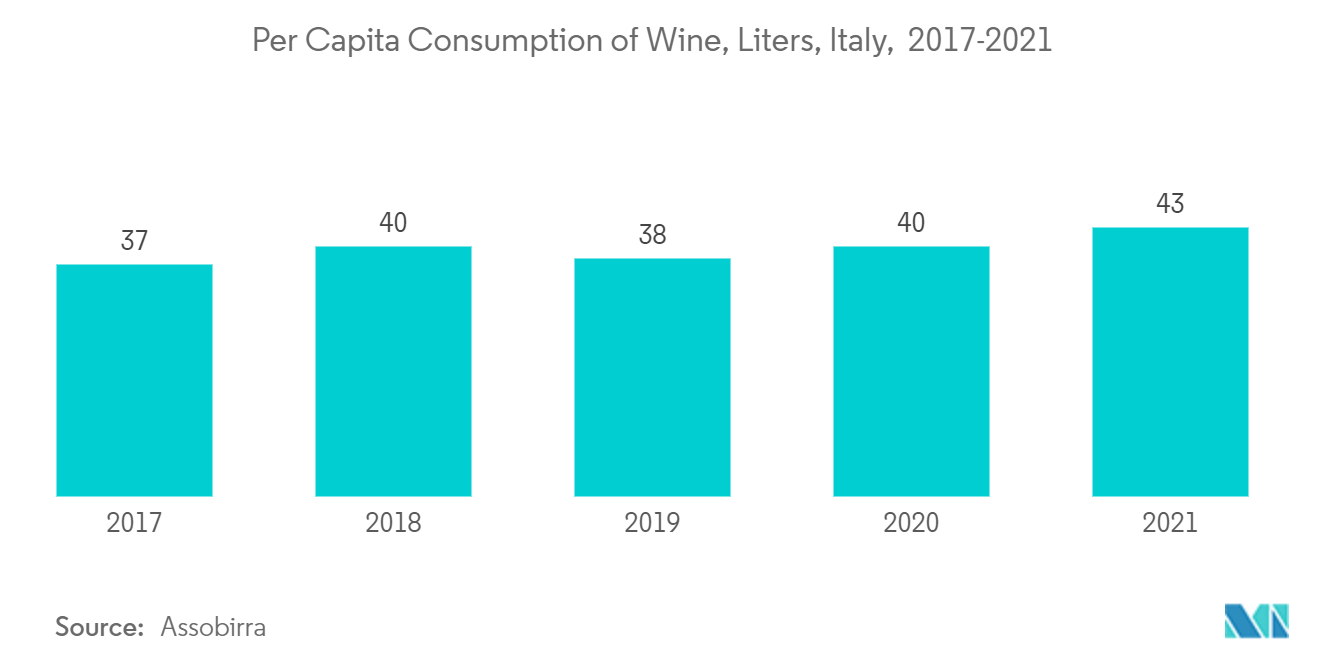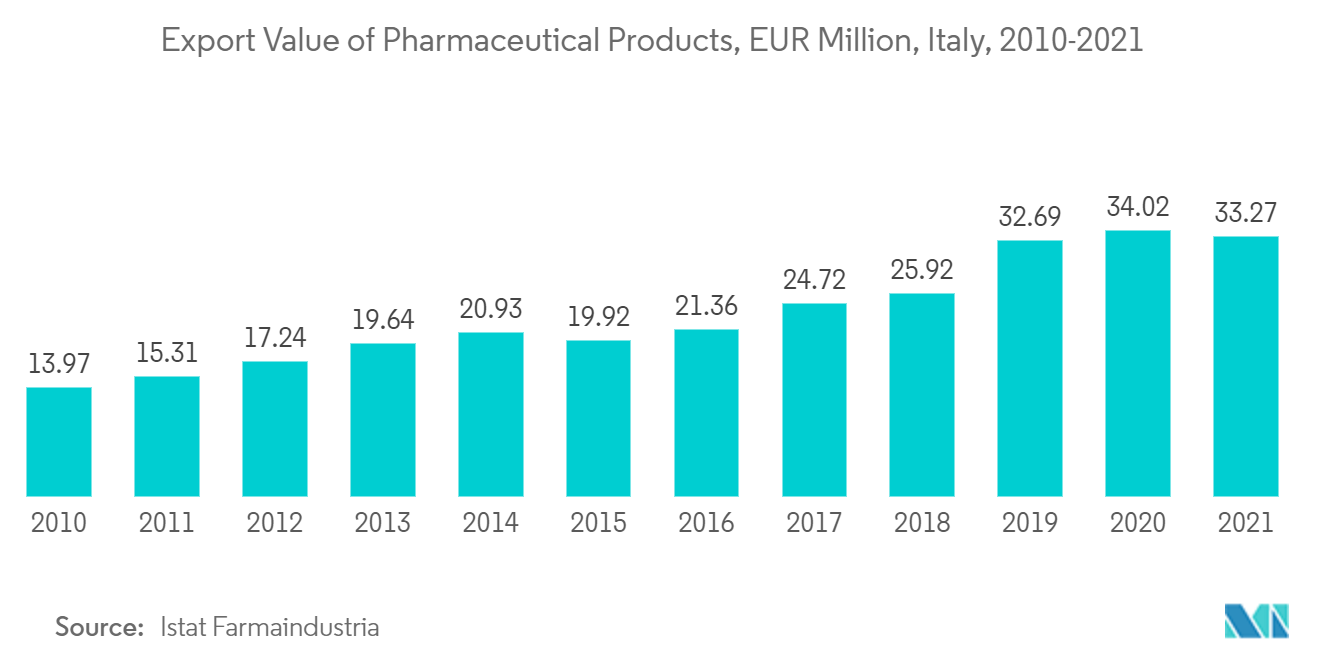Market Trends of Italy Container Glass Industry
This section covers the major market trends shaping the Italy Container Glass Market according to our research experts:
Growing Wine Consumption and Increasing Adoption of Glass Packaging in Food and Condiment Sector
- The Glass bottle manufacturing industry in Italy is widely associated with the wine industry and hearty foods that belong to Italian cuisine. Glass packaging is a popular choice, and most of Italy's wine, food, and condiment industry end up packaging their products in glass bottles.
- These industries heavily rely on glass bottles for their packaging needs because glass is an inert material, making it a safe option for storing products made for human consumption. Glass bottles are free from chemicals, and glass does not react with the products or the environment.
- The Italian wine supply chain has performed well in recent decades in terms of profitability and success in the domestic and international markets. This is despite the fact that it is fragmented in terms of products, prices, and consumption context, and, in particular, despite the fact that it is characterized by an organization that hinders the full exploitation of economies of scale.
- The growing consumption of wine across the country has boosted the demand for container glasses in the market. Wine is one of Italian agriculture's most traditional products and one of the most characterizing and constant elements of the diet of the Italian population. Throughout time, wine has been a cheap source of energy, an essential beverage when water was unsafe to drink, and a symbolic element of social celebrations.
- According to Assobirra, the average per capita consumption of wine in Italy has fluctuated somewhat over the period under consideration. While in 2017, 37 liters per capita were consumed in Italy, in 2021, this amount rose to about 43 liters. Italy recorded the world's second highest per capita wine consumption after Portugal. Furthermore, Wine consumption in Italy grew slightly, from 22.6 million hectoliters consumed in 2017; it rose to 24.2 million hectoliters in 2021.
- Italy is the third largest consumer of wine in the world. Red wine is still the preferred choice, but white and rosé consumption is rising. E-commerce is becoming an important sales channel to position New Zealand wines towards the new generation of consumers who appreciate the uniqueness and versatility of a different grape variety.
- According to data published by New Zealand, trade and enterprise (national statistical institute and ISME), In 2021, over 61 million bottles of organic wines will be consumed in Italy, with a 26% increase compared to 2018.
- Furthermore, the growing Italian Spirits market is also contributing to the market growth. According to the data published by Istat, the main importer of Italian spirits, liqueurs, and other alcoholic beverages in 2020 was Germany, with a value of around EUR 255 million . It was followed by the United Kingdom and France with about EUR 133 million and EUR 69 million of imports, respectively.

The Growing Demand for Glass Container in Pharmaceutical Industry
- Glass is widely used as a packaging material for various pharmaceutical products. Glass containers are among the primary packaging materials used in the pharmaceutical industry. Many pharmaceutical formulations have been packaged using glass containers, and they are usually the first choice of packaging materials.
- The pharmaceutical market in Italy is growing with significant investments from pharmaceutical companies in the region. The vast market is driving the growth of pharmaceutical glass packaging in the country, as most pharmaceutical companies prefer glass as the primary packaging material for drugs.
- In October 2021,Aenova has significantly expanded its sterile fill and finish capacity at its Italian site in Latina. The new state-of-the-art aseptic production area features a unique high-speed flexible line for vials and prefilled syringes (PFS) and a brand new compounding area. This area provides capacity for more than 80 million vials and over 180 million prefilled syringes, targeting vaccines and biologics. Further capacity expansions to four high-speed filling lines are also being planned.
- Moreover, in April 2021, a global contract development and manufacturing organization (CDMO), Aenova Group, announced its fill-finish capacity in Latina, Italy, for the production of BSL1 And BSL2 vaccines along with biologics against the SARS-CoV-2 virus. The company invested EUR 16 million for fill and finish, mainly focusing on vials. In addition, aseptic filling production is fully automated to fill the ready-to-use vials with a capacity ranging from 2 ml to 10 ml. This is expected to drive the market during the forecast period.
- For example, in January 2021, Sanofi chose EUROAPI to produce and market active pharmaceutical ingredients (APIs). The project announced by Sanofi in February 2020 aims to create a standalone company to combine Sanofi's API commercial and development activities with six of its European production sites, including Brindisi (Italy). Such moves increase opportunities for tubular vial vendors in the country.
- Further, the Vendors are engaged in coalitions for packaging the already developed COVID-19 vaccines. For example, Epidemic Preparedness Innovations signed a coalition agreement with Stevanto leading producer of pharmaceutical glass containers, to supply 100 million type-1 borosilicate glass vials to hold up to two billion doses of a vaccine against the COVID-19 virus.
- According to Istat, Farmaindustria, the export value of pharmaceutical products in Italy doubled from 2010 to 2021, going from approximately EUR 14 million to around EUR 33.3 million.


